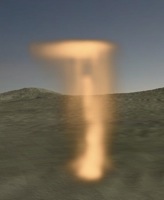Simulation
Etymology
Middle English simulacion, from Anglo-French, from Latin simulation-, simulatio, from simulare
- Date: 14th century
Definitions
- 1 : the act or process of simulating
- 2 : a sham object : counterfeit
- 3 a : the imitative representation of the functioning of one system or process by means of the functioning of another <a computer simulation of an industrial process>
- b : examination of a problem often not subject to direct experimentation by means of a simulating device
Description
Simulation is the imitation of some real thing, state of affairs, or process. The act of simulating something generally entails representing certain key characteristics or behaviors of a selected physical or abstract system.
Simulation is used in many contexts, including the modeling of natural systems or human systems in order to gain insight into their functioning. Other contexts include simulation of technology for performance optimization, safety engineering, testing, training and education. Simulation can be used to show the eventual real effects of alternative conditions and courses of action.
Key issues in simulation include acquisition of valid source information about the relevant selection of key characteristics and behaviors, the use of simplifying approximations and assumptions within the simulation, and fidelity and validity of the simulation outcomes.
Classification and terminology
Historically, simulations used in different fields developed largely independently, but 20th century studies of Systems theory and Cybernetics combined with spreading use of computers across all those fields have led to some unification and a more systematic view of the concept.
Physical simulation refers to simulation in which physical objects are substituted for the real thing. These physical objects are often chosen because they are smaller or cheaper than the actual object or system.
Interactive simulation is a special kind of physical simulation, often referred to as a human in the loop simulation, in which physical simulations include human operators, such as in a flight simulator or a driving simulator.
Human in the loop simulations can include a computer simulation as a so-called synthetic environment.
Computer simulation
A computer simulation (or "sim") is an attempt to model a real-life or hypothetical situation on a computer so that it can be studied to see how the system works. By changing variables, predictions may be made about the behavior of the system.
Computer simulation has become a useful part of modeling many natural systems in physics, chemistry and biology, and human systems in economics and social science (the computational sociology) as well as in engineering to gain insight into the operation of those systems. A good example of the usefulness of using computers to simulate can be found in the field of network traffic simulation. In such simulations, the model behavior will change each simulation according to the set of initial parameters assumed for the environment.
Traditionally, the formal modeling of systems has been via a mathematical model, which attempts to find analytical solutions enabling the prediction of the behavior of the system from a set of parameters and initial conditions. Computer simulation is often used as an adjunct to, or substitution for, modeling systems for which simple closed form analytic solutions are not possible. There are many different types of computer simulation, the common feature they all share is the attempt to generate a sample of representative scenarios for a model in which a complete enumeration of all possible states would be prohibitive or impossible.
Several software packages exist for running computer-based simulation modeling (e.g. Monte Carlo simulation, stochastic modeling, multimethod modeling) that makes the modeling almost effortless.
Modern usage of the term "computer simulation" may encompass virtually any computer-based representation.
